Archive for the ‘News’ Category
IOBA Newsletter No1 – Front Cover Autumn 1983
Indefatigable OBA Newsletter No1 Front Cover Autumn 1983
Newsletter Editor Mr. P.J. Purser
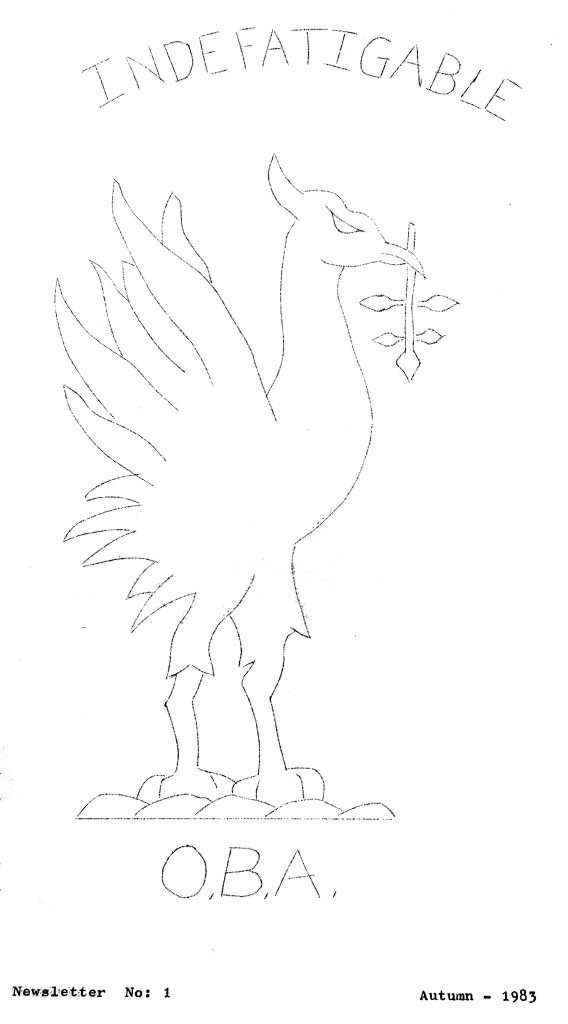
Indefatigable Old Boys Association (IOBA)
© www.indeoba.com 2020
Training Ships on the Mersey
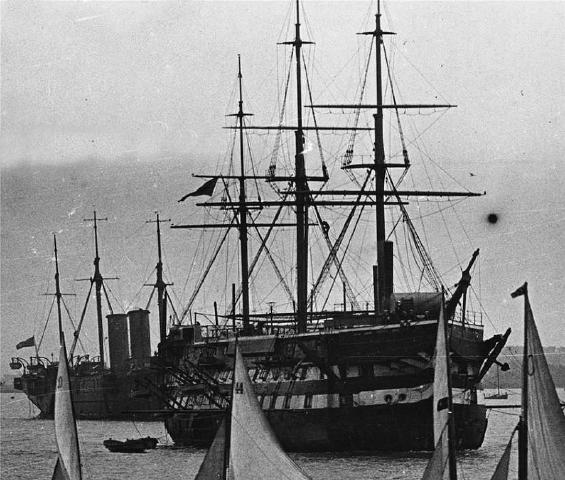
The Akbar and The Clarence were both reformatory ships for boys who had been in trouble with the law. HMS Conway trained boys from better off backgrounds to be officers in the Merchant Navy whilst the Training Ship Indefatigable was for poor and orphaned boys whose fathers were seamen. These ships made a valuable contribution to the life of the port of Liverpool. They helped boys from difficult social backgrounds to gain the skills necessary for a life at sea. The schools closed as demand for merchant seamen declined after the Second World War.
Two schools were established in Liverpool, HMS Conway, to prepare boys to go to sea as apprentice officers, and TS Indefatigable to prepare boys for life at sea as a member of the deck crew.
In 1863 captain John Clint, a Liverpool shipowner, proposed the idea that a sea training school should be established for the orphans and sons of Liverpool seamen. Clint had helped found the Liverpool Shipowners’ Association in 1839, the Pilots’ Commission, the Dock and Harbour Company, the Liverpool Sailors’ Home, the Northern Hospital, but most importantly Clint had been the prime mover in establishing HMS Conway and the Akbar, a reformatory school for boys.
In 1864 the Admiralty agreed to loan HMS Indefatigable, a fifty–gun sailing ship frigate, launched in 1848, and retired from active service in 1857 to the Indefatigable committee. Mr. James Bibby contributed £5,000 to convert HMS Indefatigable into a training ship, and this became the beginning of a long relationship between the Bibby family and TS Indefatigable, which continues today with Sir Michael Bibby as President of the Indefatigable Old Boys Association. The Indefatigable was moored off Rock Ferry on the River Mersey alongside HMS Conway, Akbar and Clarence, both reformatory ships. The first boys to join the Indefatigable did so on the 28th August 1865.
The original Indefatigable remained off Rock Ferry until 1912 when it was deemed unfit for use. In 1913, the Admiralty agreed to sell HMS Phaeton to the Indefatigable committee for £15,000. Mr. Frank Bibby gave the Indefatigable committee the money to buy the Phaeton and re-fit her as a training ship. The Phaeton was renamed the Indefatigable and moored off Rock Ferry on January 15, 1914, at which time the figurehead of William IV was transferred from the old Indefatigable to the new Indefatigable.
From quarantine to borstal, ships in the Mersey hide stories of misery, sickness and brutality
In the 1830s the Akbar (right) was moored off Rock Ferry as a quarantine ship for cases of bubonic plague, cholera, typhus and smallpox.
In 1856 it became a floating borstal for Protestant boys aged 11-15 (the Clarence became a Catholic borstal a few years later). The Recorder of Liverpool reported in 1866, “The two Reformatory ships have succeeded to a very large extent in clearing the town of juvenile crime”.
Conditions on these ships were extreme. In winter the boys suffered from chilblains, tuberculosis, pneumonia and asthma.
Horrendous accidents have been described in the old Minute Books of the Akbar: One boy “while employed in blacking a portion of the rigging was accidentally jerked off and thrown down from a height of 16 feet on to the deck, dying three hours later…” Another “fell from the main top deck and received concussion and partial jaw fracture, was recovering ..” Yet another “while manning the working boat, slipped and was crushed between the boat and the ship side. His body was washed up on shore …”
Physical punishment included birching and caning. In August 1872, one lad was so worried about this that one night he clambered down to the bottom of the accommodation ladder to wash out his blanket before official inspection. He overbalanced and fell into the Mersey. His body was never found.
The Akbar moved to land and became Heswall Reformatory School on 2 December 1907. But the ill treatment continued. John Bull magazine exposed this in 1910 with the headline: “Reformatory School Horrors – How Boys at the “Akbar” School are Tortured – Several Deaths”. Winston Churchill assured Parliament that there was “no proof whatever” they were being mistreated. Nevertheless he set up an investigation into the incidents.
Boys had been gagged before birching, sick boys caned for malingering. No less than 27 had permanent scars from beatings. Others had been made to stand all night as a collective punishment. There had been four deaths in 1909: a boy called Brooks, who was going to be caned on the day he died, even though he was ill. Brown was drenched with water and died twenty minutes later. Mills just collapsed and died. Yeadon was, “a weakly boy – probably a boy of degenerate type, utterly unfit for sea-life or ordinary industrial training.”
Despite all the criticisms the inquiry did not recommend any changes, although the Chief Officer resigned. John Bull reported reprisals against boys who had given evidence.
1.Between 1824 and 1863 there were at least ten quarantine hulks moored off Rock Ferry – at one stage six were there simultaneously.
2.There were actually four ships off Rock Ferry. The other two were The Conway (1859) used for the training of officers in the Merchant Navy, and The Indefatigable (1865), a school for destitute and orphan boys from Liverpool.
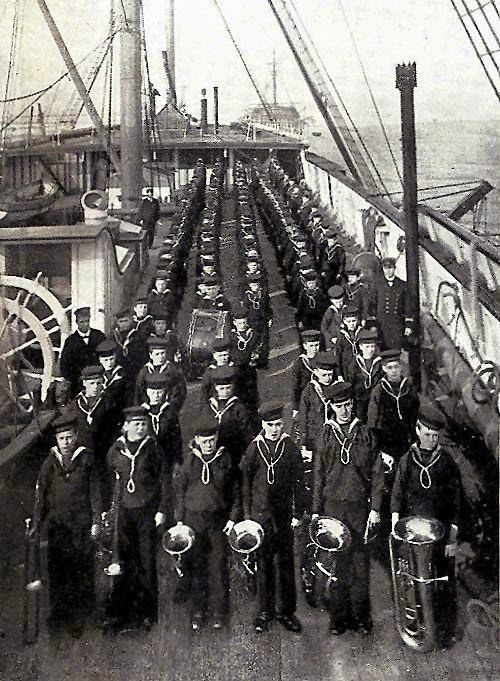
Indefatigable Old Boys Association (IOBA)
© www.indeoba.com 2020
Aboard the Indefatigable 1883
All credits go to the Together Trust so that readers may approach the Trust with any enquiries about their other collections.
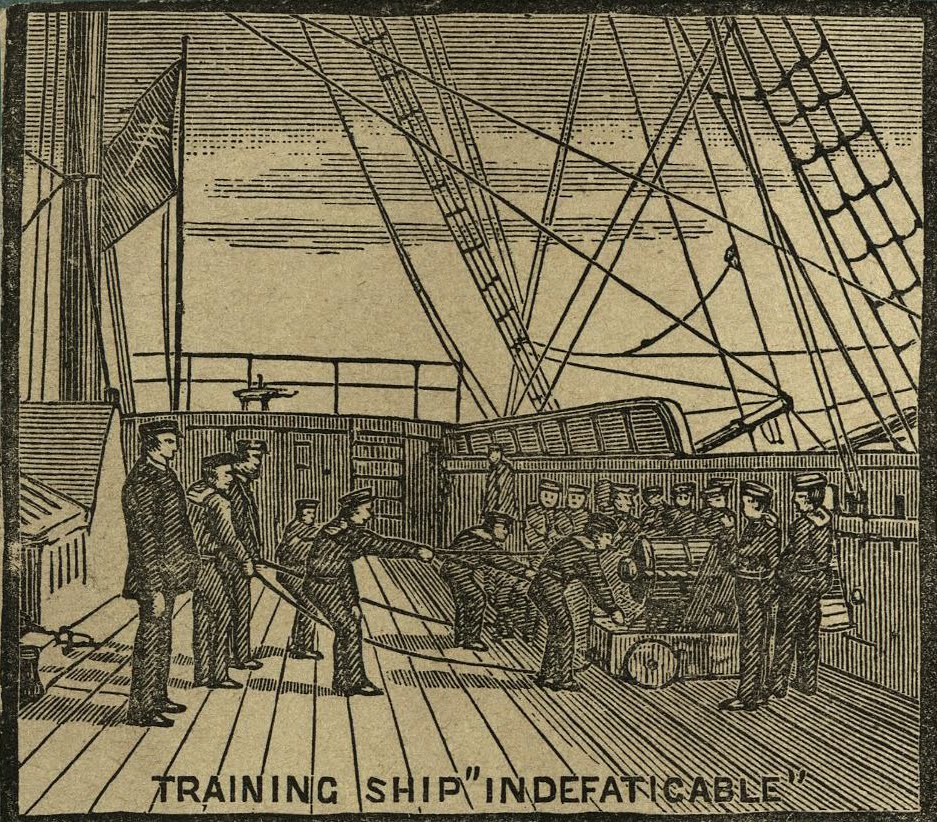
Aboard the Indefatigable, 1883 This was a training ship for ‘destitute lads of good character’. Boys would sign up for a three-year course to learn to be a seaman. The Christian Worker edition of 1887 gives a detailed account of a typical day aboard the ship, which would have been experienced by the boys on board: The boys are divided into two watches, the port and the starboard. From 9am to 12 noon one set are engaged in ordinary school duties, going through a systematic course of reading, spelling, writing, geography, arithmetic, dictation and scripture. The other set are meanwhile pursuing a course of technical instruction at the opposite side of main deck. The second set of lads are engaged in making clothes, learning to knot and splice, to make hammocks and mats and, when weather permits, are initiated into the practice of a sailor’s life. In the summer, they are accustomed to going aloft, to setting and reefing sails, sending up and down masts and yards, and generally, are taught as much practical navigation as can be imparted upon a training-ship in berth. The ship was supported by voluntary contributions and was under the joint management at the time of Charles Bushell and Thomas Henry Ismay. Thomas was the Father of Joseph Bruce Ismay, the notorious managing director of the Titanic when the ship sunk in 1912. He had founded the White Star Line but also gave generously to many seafaring charities. Training ships were not for the faint hearted, life on board could be extremely tough. As well as teaching the usual subjects like reading and arithmetic (education was compulsory after the Elementary Education Act 1880), the boys also learnt about practical seamanship, such as navigation, use of the compass and reefing and furling sails. They slept on board in hammocks, cleaned the ship themselves and washed and mended their own clothes.
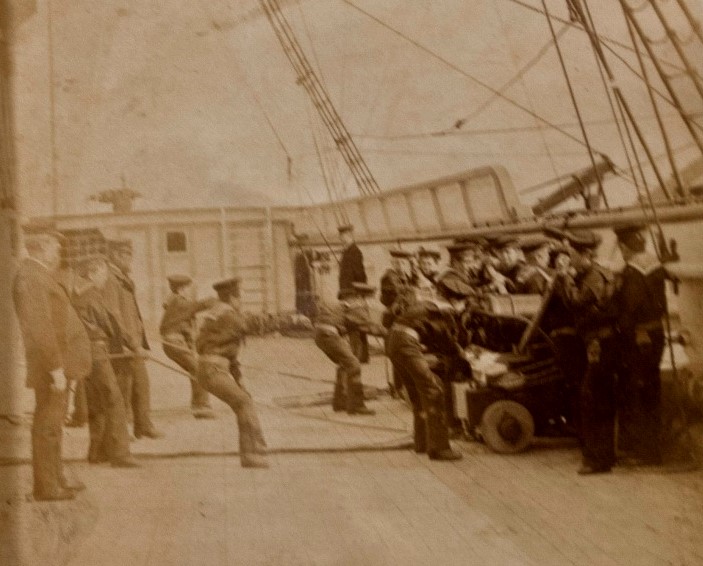
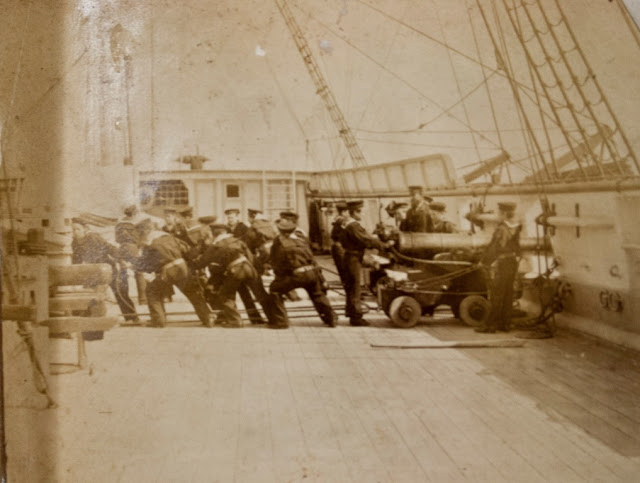
Although the Refuge was sending boys to the Indefatigable as early as 1872, other ships were also used by the Committee to train the boys for a life at sea. One of these was the HMS Warspite, which was anchored off Woolwich, Kent. The Warspite had accommodation for 500 boys on board. A yacht was attached to the ship, and a shore establishment included swimming baths, hospital, laundry and storehouses. However Birkenhead wasn’t the only destination for those with sea legs. In the early days many lads were also sent south to Woolwich to be taken aboard the Warspite. This ship had been owned by the Marine Society since 1862 and trained up to 200 lads for a life at sea.
Thomas, a Refuge boy who ended up on the charity’s training ship, the Indefatigable. So why when the Refuge had so many homes of their own did they turn to the Indefatigable? Lets take the case of little Tommy as an example. At the age of 12 he appeared at the Refuge, a ragged waif, drifting towards a life of uselessness and crime. He was sent across to the Indefatigable and whilst there received the Silver Medal of the Liverpool Humane Society for “gallantly jumping into the river and rescuing a shipmate who had fallen from the fore chains, and was rendered insensible by striking against the anchor in his descent.” He went from a nobody to a hero – a sturdy lad in England’s first line of defence. The training ship provided a skill and a better life – that’s why Thomas first came to the attention of the Manchester and Salford Refuge in 1896 when he turned up at midnight at the open-all-night shelter on Chatham Street, accompanied by a policeman. At the tender age of 12 years he had been sleeping on the streets of Manchester as he had nowhere else to go. Whilst resident at the shelter his circumstances were investigated by the Committee.
“I have made enquiries and find the boy has slept out on several occasions, that his mother is a very violent woman. All the children have been driven from home by the disreputable mother. Two sisters confirm this and say they would be thankful if anything could be done for Tom.”
Tom was quickly admitted and transferred across to the Central Refuge on Francis Street. Here he mixed with older boys, continuing his education. On 3rd May 1897, he was admitted to the Indefatigable training ship as a cadet, which was moored in Birkenhead. The ship trained those disposed for a sea life and after two years training Tom sailed for South America in May 1899 on board the Oravia.
“At a meeting of the Committee of the above at the Underwriter’s Room, April 27 1899, it was resolved unanimously that the thanks of the Committee be presented with a silver medal and 5/- to Thomas …… for gallantly jumping into the river from the training ship Indefatigable on April 20 1899, and rescuing a ship mate who had fallen from the forechains and was rendered insensible by striking against the anchor in his descent’”.
Thomas eventually became a US citizen, married and moved to Baltimore.
Not bad for a boy from the Manchester streets.
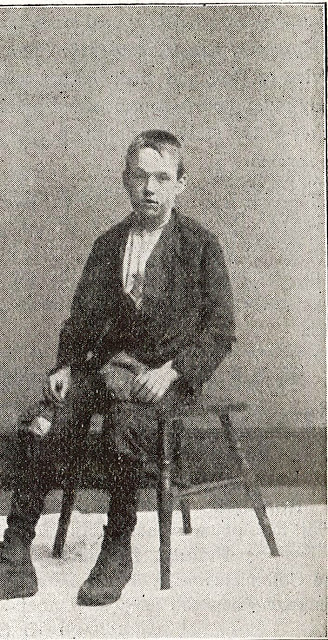
All credits go to the Together Trust so that readers may approach the Trust with any enquiries about their other collections.
Indefatigable Old Boys Association (IOBA)
© www.indeoba.com 2020
New image come to light: Indefatigable 1936
Courtesy of: Geoff Stephens is at River Mersey.
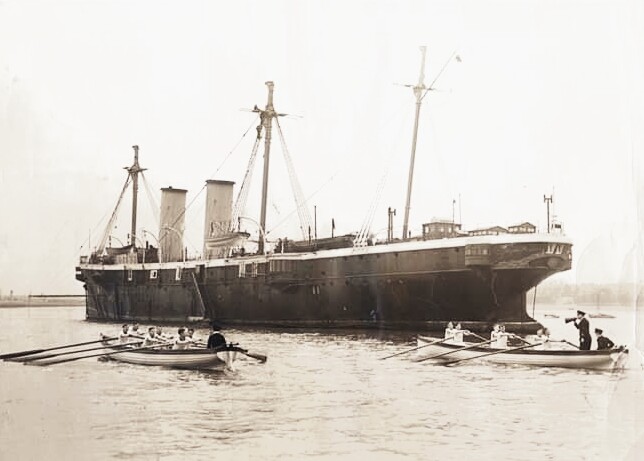
This picture was published in May 1936 in the Daily Post. The caption reads ‘The racing crews of the Mersey Schoolship Conway in training for the forthcoming race to be held on the Mersey against boys of H.M.S. Worcester passing the training ship Indefatigible during practice yesterday.’ The photographer is unknown.
Indefatigable Old Boys Association (IOBA)
© www.indeoba.com 2020